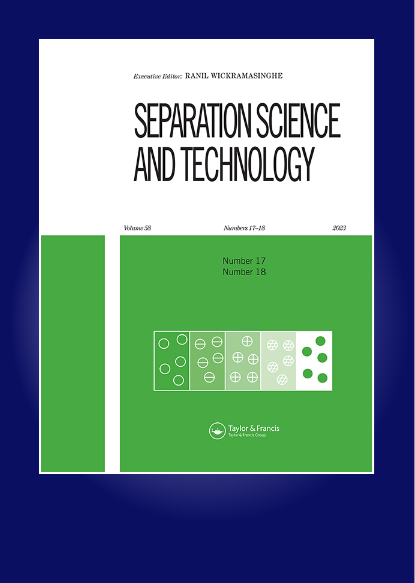复合膜基蒙脱土的制备及其除铅性能研究
IF 2.3
4区 工程技术
Q3 CHEMISTRY, MULTIDISCIPLINARY
引用次数: 0
摘要
摘要:以百香果皮为原料制备蒙脱土和天然果胶复合膜,用于去除水中的铅。气体吸附分析仪、场发射扫描电子显微镜、傅里叶变换红外光谱仪和织构分析仪是表征吸附剂的设备。在果胶膜中加入蒙脱土,得到了强度更高的复合膜。通过批量试验研究了接触时间、初始pH溶液、初始金属浓度和温度对吸附的影响。在最佳条件下,初始pH为5.0,初始金属浓度为100 mg/L,接触时间为150 min,温度为313 K时,铅的最佳吸收量为110.03 mg/g。实验数据符合Langmuir等温线和伪二阶方程。以0.1 M HCl为洗脱剂,吸附剂的铅离子去除率约为90.54%。结果表明,该复合膜可去除污染水中的铅离子,并可重复利用。本文章由计算机程序翻译,如有差异,请以英文原文为准。
Preparation of composite film-based montmorillonite clay for removal of lead from aqueous solution
ABSTRACT This study aimed to prepare a composite film made of montmorillonite clay and natural pectin from passion fruit peels to remove lead from an aqueous solution. A gas adsorption analyzer, a field emission scanning electron microscope, a Fourier transform infrared spectrometer, and a texture analyzer are the devices for the adsorbent’s characterization. Adding montmorillonite to the pectin film produced the composite film, which has more strength. Batch tests were carried out to study the effects of contact time, the initial pH solution, the initial metal concentration, and temperature on adsorption. Under an optimal condition, a contact time of 150 min with an initial pH solution of 5.0, an initial metal concentration of 100 mg/L, and a temperature of 313 K results in the optimum amount of lead taken up at 110.03 mg/g. The experimental data follows the Langmuir isotherm and the pseudo-second-order equations. 0.1 M HCl used as the eluent can remove about 90.54% of the lead ions from the used adsorbent. The outcomes show that the composite film can remove lead ions from contaminated water and allow reuse.
求助全文
通过发布文献求助,成功后即可免费获取论文全文。
去求助
来源期刊

Separation Science and Technology
工程技术-工程:化工
CiteScore
6.10
自引率
3.60%
发文量
131
审稿时长
5.7 months
期刊介绍:
This international journal deals with fundamental and applied aspects of separation processes related to a number of fields. A wide range of topics are covered in the journal including adsorption, membranes, extraction, distillation, absorption, centrifugation, crystallization, precipitation, reactive separations, hybrid processes, continuous separations, carbon capture, flocculation and magnetic separations. The journal focuses on state of the art preparative separations and theoretical contributions to the field of separation science. Applications include environmental, energy, water, and biotechnology. The journal does not publish analytical separation papers unless they contain new fundamental contributions to the field of separation science.
 求助内容:
求助内容: 应助结果提醒方式:
应助结果提醒方式:


